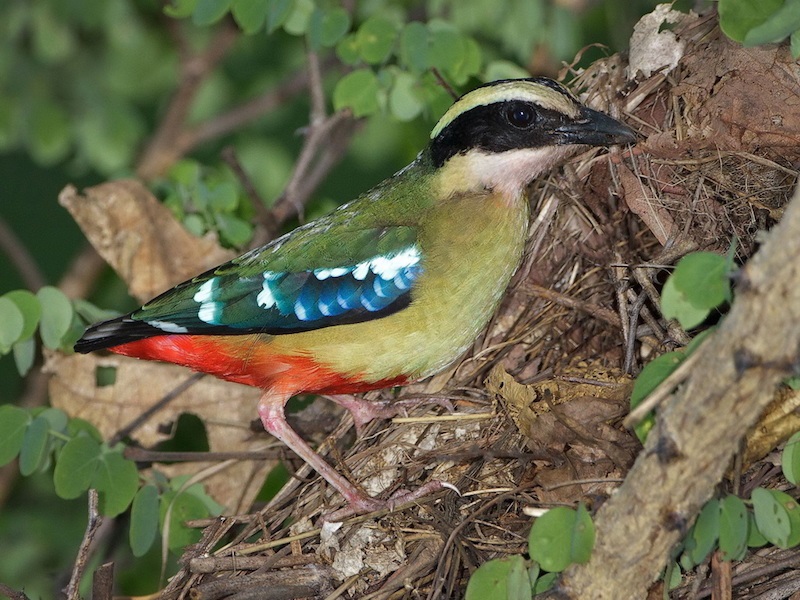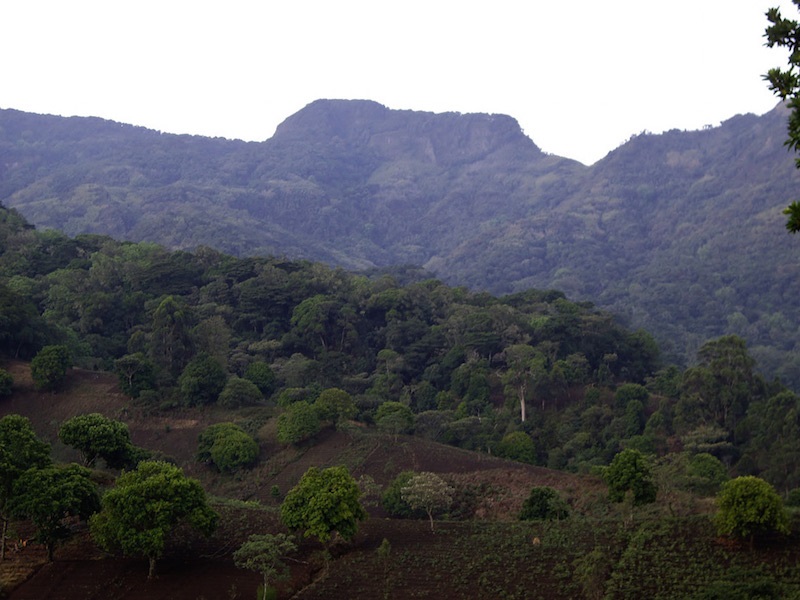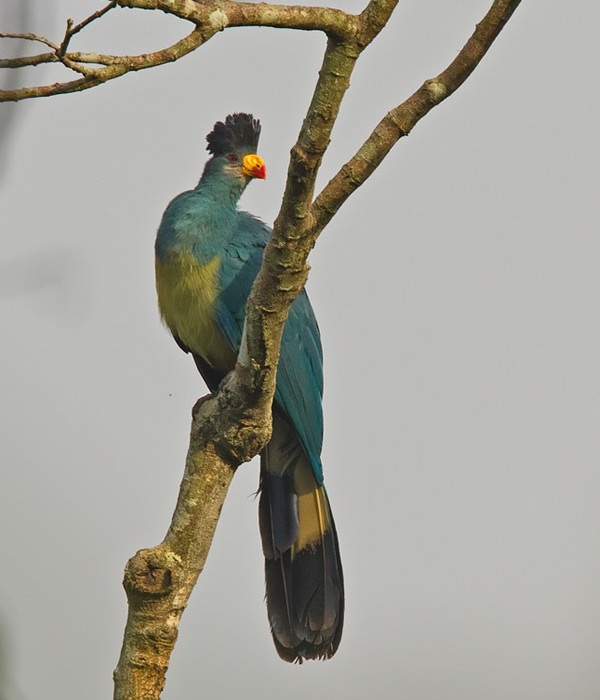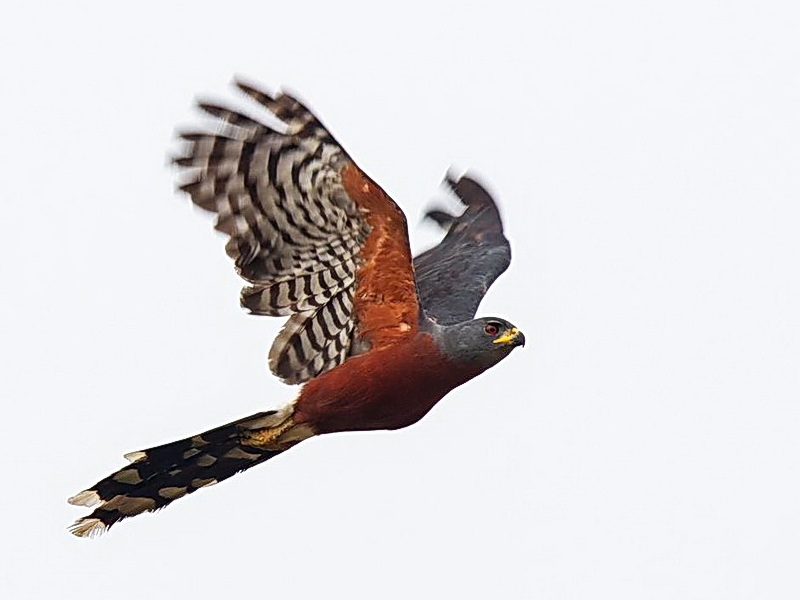Cameroon remains little known ornithologically, despite being the richest country in West Africa for birds. It is probably the most accessible country in West-Central Africa with many exceptionally exciting birds. Lying at the junction between West and Central Africa, Cameroon supports 968 bird species (2016). Of these, 704 are resident, 218 are seasonal migrants (145 from the Palaearctic and 73 intra-African). Seven species are endemic to geographical Cameroon. However, two vital Endemic Bird Areas form a major part of Cameroon, Cameroon and Gabon lowlands (EBA 085); which has six species found nowhere else in the world, all of these occur in Cameroon including the mythical Grey-necked Rockfowl. The other EBA, the Cameroon Mountains (EBA 086); holds some 29 restricted range endemics that are confined to Cameroon, and a small portion of Nigeria.
Access – Although occasionally frustrating, Cameroon is a well-connected country with a road and air network that can (and usually does) get one from A to B very effectively. Regular flights connect the two main birding zones in the north and south of the country and the roads in the north are good year-round. In the south, it is best to avoid the rainy season between May and August when the roads become muddy paths and places such as Korup are virtually inaccessible. For most of the year however, although the roads are poor, most sites can be visited.

Timing – March and early April are the optimal times to visit Cameroon. This is before the heavy rains come, but many birds in the south are actively setting up territories and many of the seasonal migrants are still present in the far north. Avoid going to the south in May to August when rain can severely impact your chances of making it to your preferred destinations, and even if you get there you may still be rained out.
Topography – Mount Cameroon, just to the southwest of Douala, is the tallest peak in West Africa at 4,095m. It dominates the southwestern portion of the country. It is connected to the Cameroon Highlands, which comprise the Rumpi Hills, Mt Kupé, & Bamenda Highlands, which penetrate into Nigeria (the Obodu Plateau). Geographically, these highlands are connected to offshore Bioko and are part of a continuous volcanic intrusion that extends inland as far as the Adamawa plateau and the Mandara Mountains in the northwest at 11°N. The remainder of the country comprises mostly flat lowlands undulating between 800m and sea-level.
Birding Habitats – The diversity of habitats is staggering and is replicated no-where else in West Africa. Far north Cameroon comprises the low sparse thorn-dominated woodlands and grasslands of the Sahel biome. This extends from just north of Benoue. There are many characteristic species of this dry woodland-grassland mosaic, although they are shared with many other West African nations. To the south, Cameroon is covered by Guinea savannah, which is a broad-leaved woodland. The third major habitat is Afro-montane Forest. Within Cameroon, this habitat is found on Mt Cameroon, Mt Kupé, the Bamenda-Banso highlands and supports 29 restricted range species in the Cameroon Mountains (EBA 086); which are confined to Cameroon, and a small portion of Nigeria.
They include: Mount Cameroon Francolin, Cameroon Olive Pigeon, Bannerman’s Turaco, Mountain Saw-wing, Cameroon Greenbul, Grey-throated Greenbul, Cameroon Olive Greenbul, Grey-headed Greenbul, Yellow-breasted Boubou, Mount Kupé Bush Shrike, Green-breasted Bush Shrike, Monteiro’s Bush Shrike, Mountain Robin Chat, White-throated Mountain Babbler, Brown-backed Cisticola, Green Longtail, Bamenda Apalis, Bangwa Forest Warbler, White-tailed Warbler, Black-capped Woodland Warbler, Fernando Po Batis, Banded Wattle-eye, Cameroon Sunbird, Ursula’s Sunbird, Mount Cameroon Speriops, Fernando Po Speriops, Fernando Po Oliveback and Bannerman’s Weaver. Although only seven of these species are geographically endemic to Cameroon, all of them are most easily seen here.

The remainder of the country, particularly in the far south and west comprises lowland Guinea-Congo Forests. Another vital Endemic Bird Area forms this part of Cameroon, Cameroon and Gabon lowlands (EBA 085), which has six species found nowhere else in the world; all of these occur in Cameroon, Forest Swallow, Grey-necked Rockfowl, Dja River Warbler, Gabon Batis, Bates’s Weaver and Rachel’s Malimbe. Added to the plethora of endemics many non-endemic specials are found in Cameroon, not least of which are Egyptian Plover, Arabian Bustard, Quail Plover, Stone Partridge, Violet Turaco, Sudan Golden Sparrow and Scissor-tailed Kite in the northern savannas and Grey Pratincole, Bare-cheeked Trogon, Grey-sided and Red-sided Broadbills in the forested southwest.
Major Wildlife Viewing Areas include:
Bamenda Highlands: Bafut-Nguemba Forest Reserve
This area comprises remnant montane and riverine forest within the Cameroon Mountains EBA. Leaving Bamenda, it is worthwhile checking the grounds of the Bali Safari Lodge, where Bamenda Apalis has been recorded, particularly on the stretch of road towards Bamenda, check the first 500m. To get to Bafut-Nguemba, turn east off the N6 18 km south of Bamenda, or 33 km north of Mbouda, drive a further three kilometres before reaching forested gullies amongst Eucalyptus plantation. Although all the specials have been seen here, you can head straight up to Lake Awing, where most of the target birds are easy. Bannerman’s Turaco, Banded Wattle-eye and Bannerman’s Weaver are all seen here with relative ease. It is undoubtedly the best site to see two highly localised endemics: Bannerman’s Turaco and Banded Wattle-eye and the near-endemic Bannerman’s Weaver. The best area for these birds is right next to Lake Awing. Other specials that can be seen here include Yellow-breasted and Mountain Boubou Shrike, Brown-backed Cisticola, Bangwa Scrub Warbler, Mountain Robin Chat, Forest Swallow, Cameroon Mountain Greenbul, Green Longtail and Cameroon Sunbird. Little Grey Flycatcher, Grey-chested Illadopsis, Black-collared Apalis, Congo Serpent Eagle and a mystery nightjar were seen here in 2003.
It is best to spend a night in Bamenda at the Skyline Hotel where both White-crowned Cliff Chat and Neumann’s Starling can be seen in the garden! Leaving Bamenda, it is worthwhile checking the grounds of the Bali Safari Lodge, where Bamenda Apalis has been recorded, particularly on the stretch of road towards Bamenda, check the first 500 m. To get to Bafut-Nguemba, turn east off the N6 18 km south of Bamenda, or 33 km north of Mbouda, drive a further three kilometres before reaching forested gullies amongst Eucalyptus plantation. Although all the specials have been seen here, if you can head straight up to Lake Awing, where most of the target birds are easy. Bannerman’s Turaco, Banded Wattle-eye and Bannerman’s Weaver are all seen here with relative ease. Other excellent specials one might notch up in this seemingly unimpressive forest patch include Cassin’s Hawk-Eagle, Yellow-breasted Boubou, Mountain Boubou, Mountain Robin-Chat, Forest Swallow, Petit’s Sawwing, Cameroon Mountain Greenbul, Cameroon Olive-Greenbul, Cameroon Sunbird, Oriole Finch, Purple-throated Cuckoo-Shrike, Ruwenzori Hill-Babbler, Elliot’s Woodpecker, Brown-capped Weaver and Johanna’s Sunbird. The best areas also include Mt Oku.

Benoue National Park is situated roughly halfway between Garoua and Ngaoundéré in the northern Guinea savannah belt in north Cameroon and the two national park entrances are at the small towns of Mayo Alim and Banda. Accommodation is available at Campement du Bufflé Noir which have chalets with private facilities. It is only possible to visit this reserve with a vehicle. It is possible with a saloon car, but one is restricted to driving on the main roads in the park, the other roads are too bad, especially at the small watercourses. The low rocky hills covered with orchard-like open forest support specials of this zone including Adamawa Turtle-Dove, White-throated Francolin, Emin’s Shrike and Rufous-rumped Lark. Some of the best birding is in the Campement du Bufflé Noir’s garden along the Benoue River.
Prime specialities on the river are Egyptian Plover as well as Three-banded and White-headed Plover. At dusk check the terrace along the Benoue River for Bat Hawk and Standard-winged Nightjar. A walk along the river with a gard may be arranged in the morning, providing opportunities to see Grey Kestrel, White-crested and Violet Turaco, Giant Kingfisher, Bearded Barbet, Pearl-spotted Owlet, White-breasted Cuckoo-Shrike, Sulphur-breasted Bushshrike, Spotted Creeper, Yellow Penduline Tit, Swallow-tailed Bee-eater, Little and Black-headed Weaver and Cinnamon-breasted Bunting. Other Guinea savanna specials include Blue-bellied Roller, Grasshopper Buzzard, Stone Partridge, Four-banded Sandgrouse, Bruce’s Green Pigeon, Senegal Parrot, White-crested and Violet Turaco, Abyssinian Roller, Abyssinian Ground-Hornbill, Heuglin’s Wheatear, Yellow-billed Shrike, Senegal Batis, White-fronted Black-Chat, Senegal Eremomela, Bush Petronia, Black-faced and Black-bellied Firefinch, Red-winged Pytilia and Pygmy Sunbird.
Dang Lake (Map)
Dang lake is a large shallow lake, just north of Ngaoundéré near the university alongside the road north to Garoua and is visible from the main road. It is usually visited from Ngaoundaba Ranch. It is best to visit this lake in the early morning, so that the heat haze is greatly reduced. We explored the lake from three different places: from the road to Garoua and from two different places at the university. However it was impossible for us to identify the birds on the middle of the lake. Birds include Little Grebe, Long-tailed Cormorant, White-faced Whistling-Duck, African Pygmy-Goose, Yellow-billed Duck, Little Egret, Grey Heron, Great Egret, Squacco Heron, Black Kite, Hooded Vulture, Western Marsh-Harrier, Lesser Moorhen, African Jacana, Lesser Jacana, Wood and Common Sandpiper, Spur-winged Plover, Pied Kingfisher, Woodchat Shrike, Sedge Warbler, Crested Lark.

Korup National Park was proclaimed in 1986, covering 1259 km2 of unique lowland rainforest in southwest Cameroon and is situated on the Cameroon/Nigeria border in southwest Cameroon. There are two HQs for Korup. The most popular one is at Mundemba in the south, where one can stay at the Hotel Iyaz, and at Nguti in the north. Mundemba is six hours by rough road from Kumba. Potential visitors to the southern part of Korup during the heavy rains (late July-September) should bear in mind that, even with four-wheel drive vehicles, reaching Mundemba can be extremely time-consuming. A forest refugium that survived more than 60 million years, this isolate of lower guinea rainforest supports a greater diversity of plant and animal species than comparable forests elsewhere in Africa. It supports more than 425 species of birds; there are also 174 species of reptiles and amphibians as well as 140 species of fish from the Korup area. Many, many lowland forest birds are found at Korup, but perhaps the greatest prize is the Grey-headed Rockfowl. Other delights include Black Guineafowl and Black-eared Ground-Thrush. The best areas include: Mundemba, Picathartes Knoll, the trails to and from Rengo Camp, & Nguti.
An active volcano, the isolated Mount Cameroon is a huge mountain that rises from the ocean and is West Africa’s largest free-standing mountain rising to over 4000 m a.s.l. Although a great deal of the mountain has been deforested, the remaining natural vegetation supports the Mount Cameroon Francolin and Cameroon Speriops, which are found no-where else in the world as well as Brown-backed Cisticola, Cameroon Pipit and Bates’ Weaver which are Cameroon endemics. Other specials the mountain hosts are Cameroon Olive Pigeon, Western Green Tinkerbird, Yellow-breasted Boubou, Green-breasted Bush Shrike, Mountain Robin-Chat, Mountain Saw-wing, Cameroon Mountain and Grey-headed Greenbuls, Green Longtail, Cameroon Scrub Warbler, White-tailed Warbler, Yellow Longbill, Black-capped Woodland Warbler, Fernando Po Oliveback, Cameroon and Ursula’s Sunbirds. It is possible to stay in the Miramar Beach Hotel in the Limbe Botanical Gardens on the shores of the Atlantic Ocean gardens or a hotel in Douala. The best areas include Buea (Approximately 70km west of Douala). The Mountain is accessible from the town of Buea. It is possible to walk up to 2000 m a.s.l., where one can search for Cameroon Pipit and the Cameroon Speriops. Visitors need a permit from the Tourism Office in Buea] and Limbe [The Botanical Gardens at Limbe can be very rewarding and interesting species to be seen here include Blue-headed Wood-Dove, African Blue-Flycatcher, Rufous-vented Paradise-Flycatcher, MacKinnon’s Shrike, Brown-throated Wattle-eye, Cassin’s Flycatcher, Grey-headed Negrofinch, Slender-billed Weaver, Vieillot’s Black Weaver, Western Bluebill, Reichenbach’s Sunbird, Green-headed Sunbird and Carmelite Sunbird. Tracks up the mountain can be reached from Mapanja, a villiage just above Limbe].

Mount Kupe National Park (Map)
An isolated massif, Mount Kupé is arguably the premier birding destination in Cameroon. It is a 3-4 hours drive from Douala via Loum and Tombel. The road is paved to Loum, but from Loum to Nyasoso the road is poor. It is best to base yourself at Nyasoso (850m) where the WWF is based. Accommodation is available in the village, particularly the womans centre which may serve the best food in Cameroon! Reservations can be made via the WWF. Contact WWF Cameroon, BP 2417, PMB, 1 Bonanjo, Douala (tel/fax: +237 432171). There are three main trails leading from Nyasoso onto Mount Kupé. All the trails can be hard to find, and the local guides, who can be arranged at Nyasoso (HQ or at the guesthouse), are compulsory. Although only 25 km2 of primary forest remains, a list of over 320 species including some of Africa’s rarest birds, including Mount Kupé Bushshrike tempt even tropo-phobic birders here. The forests are also home to a total of 27 of the Cameroon Mountain EBA birds including as well as many scarce or threatened species which despite having a more extensive range are difficult to see anywhere in Africa.
Diversity is high, with 8 species of kingfishers, 8 woodpeckers, 3 trogons, 7 honeyguides, 21 greenbuls, 14 shrikes, 5 wattle-eyes and 17 sunbirds. The most sought-after other specials are Cameroon Olive and White-naped Pigeons, Sjostedt’s Owlet, Bare-cheeked Trogon, Western Green Tinkerbird, Zenker’s Honeyguide, Grey-headed Broadbill, Mountain Boubou, Green-breasted Bush Shrike, Black-necked Wattle-eye, Crossley’s Ground Thrush, Mountain and White-bellied Robin-Chats, Forest Swallow, Cameroon Mountain and Grey-headed Greenbuls, Green Longtail, White-tailed Warbler, Black-capped Woodland Warbler, White-throated Mountain Babbler, Grey-necked Rockfowl, Fernando Po Oliveback, Cameroon and Ursula’s Sunbirds. Best areas include Max’s Trail, Shrike Trail and the Nature trail.

Ranch de Ngaoundaba is situated 40km south-east of Ngaoundéré. The ranch is a former hunting lodge situated in a superb setting alongside an ancient crater lake. The only place to stay is the Ngaoundaba Ranch, with chalets and private facilities. Surrounded by forest savannah mosaic, the lake and the remnant patches of gallery forest provide a perfect introduction to the birds of the Adamawa Plateau. Over 200 birds have been recorded at this ranch, amongst them a number of species difficult to see anywhere in Africa including Schlegel`s Francolin, Brown-chested Lapwing, Puvel`s Illadopsis, Thrush Babbler, White-collared Starling, Bamenda Apalis and Dybowski`s Twinspot. Some of the best birding is around the ranch buildings. The open woodland adjacent to the ranch supports White-collared Starling, Emin`s Shrike (occasionally); White-breasted Cuckoo-Shrike, Blue-bellied Roller, Brown Twinspot, Bamenda Apalis, Willcox`s Honeyguide, Marsh Tchagra, Gambaga Flycatcher, White-shouldered Black-Tit, Yellow Penduline-Tit, Sun Lark, Bar-breasted Firefinch. The gallery forest near the ranch entrance is home to Black-headed Batis, Leaf-love, Grey-winged Robin-Chat, Grey-headed Oliveback, Red-faced Pytinia, Thrush Babbler as well as two of Africa`s star turacos White-crested and Lady Ross`. Night drives offer chances of Plain, Black-shouldered, Pennant-winged, Standard-winged and Long-tailed Nightjars. The mammals are no less spectacular with Serval, Civet and many others.
Sanaga River (Map)
This spot is near to the villiage of Edea and is an excellent place to see Grey Pratincole. It is possible to reach this site by either staying in Douala or at Edea. The forest about 50 km south of Douala is excellent and warrants a search. Driving in the direction of Yaouande from Douala, one finds excellent forest after about 50 km. Here Pied, Piping, White-thighed and Black-casqued Wattled Hornbills can be seen. Red-vented and Blue-billed Malimbe, Splendid Glossy Starling, Bristle-nosed and Yellow-spotted Barbets and Speckled Tinkerbird may also be found. Sabine’s Spinetail and Bates’ Swift can be seen overhead. The Sanaga River lies c. 60km east of Douala en route to Yaoundé (N3) near the city of Edea. Just before crossing the Sanaga River turn right on the dirt road to Dizangua for c. 10km until the road runs alongside the Sanaga River. From here follow the river and check the sandbanks in the river for Grey Pratincole and African Skimmer. The magical White-throated Blue Swallow can also occasionally be seen hawking up and down the river, check exposed rocks on the river as they sometimes perch on these. The sandbanks run for 5-6km depending on the water levels. It is possible to get fishermen to take you out onto the river, so that you can walk on the sandbanks. These also hold Senegal Thick-knee and White-crowned Lapwing. It is worthwhile checking the bridge across the Sanaga River on the N3 near Edea; check the telephone wires for Preuss’ Swallows and the reeds along the river for Orange Weaver.

This national park, some 1 700 km2 in extent, in far north Cameroon is situated on the edge of the Sahel, just south of Lake Chad. The reserve supports acacia savannah, vast areas of seasonal marshes and grassland. The landscape is mostly flat although around Waza itself some impressive hills dominate the countryside for kilometres. The main camp at Campement de Waza, comprises air-conditioned chalets with private facilities. The area holds the richest birdlife in the entire Sahelian band, where the recorded list seems endless. The many small waterholes teem with waterbirds and also attract many dry-country species desperate for water in this harsh environment. The best birds at Waza include the highly sought-after Arabian Bustard. Waterholes about 8-10 km south of the park entrance on the road to Mora support River Prinia and Sennar Penduline-Tit. About 30 km north of Mora there are flocks of Sudan Golden-Sparrow and anywhere where the feathery golden grass can be found is good for Quail Plover and is excellent habitat for the recently discovered Golden Nightjar. The entire district could yield Scissor-tailed Kite. Other range-restricted birds that are best looked for in the Waza-Mora area include Clapperton’s Francolin, Black Crowned-Crane, Black Scimitar-Bill, Chestnut-bellied Starling and Black Scrub-Robin. The park is open from mid November to mid June only and it is only possible to enter with a vehicle and the company of a guide. In the dry season nearly all the roads are navigable in a 2WD, although birding by 4WD is much easier. There are three main areas to bird around Waza: Waza National Park, the pools along the main road south of Waza and the area around Waza village. Waza NP doubles as one of the best parks in West Africa for observing mammals.
Major Source: Fatbirder
Photo Source: Birding Ecotours
Map Source: Googlemaps™
